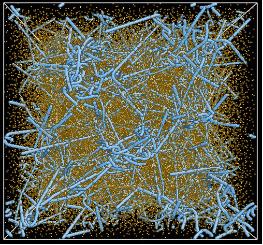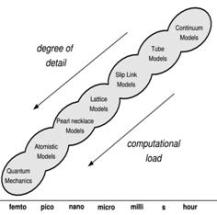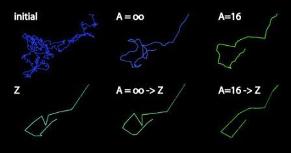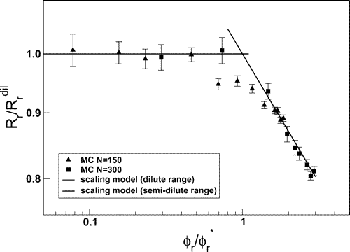SACHIN SHANBHAG |
 Larson, R.G.; Zhou, Q.; Shanbhag, S.; Park, S.J., "Advances in Modeling of Polymer Melt Rheology", AIChE J., 2007, 53(3), 542.
Larson, R.G.; Zhou, Q.; Shanbhag, S.; Park, S.J., "Advances in Modeling of Polymer Melt Rheology", AIChE J., 2007, 53(3), 542.
In this article (aimed at a broad chemical engineering audience) we summarized the state of the art in modeling the rheology of polymer melts. Key developments in the past 15 years in modeling both the linear and nonlinear rheological properties of entangled polymers are described. Outstanding problems are identified. Online article |
 Shanbhag, S.; Park, S.J.; Zhou, Q.; Larson, R.G., "Implications of microscopic simulations of polymer melts for mean-field tube theories",
Mol. Phys., 2007, 105(2), 249.
Shanbhag, S.; Park, S.J.; Zhou, Q.; Larson, R.G., "Implications of microscopic simulations of polymer melts for mean-field tube theories",
Mol. Phys., 2007, 105(2), 249.
Despite the success of the mean-field tube theory in predicting the stress relaxation of linear and branched polymers, several important issues remain unresolved. Recent simulation methods that address some of these issues are shedding light on the dynamics of entangled polymer molecules. In this survey, we consider a class of coarse-grained models for polymer melts, which have been used to study the phenomena of constraint release, branch-point diffusion, and the relationship between the plateau modulus and entanglement spacing. Online article |
 Shanbhag, S; Kroger, M, "Primitive Path Networks Generated by Annealing and Geometrical Methods: Insights into Differences",
Macromolecules, 2007, 40(8), 2897.
Shanbhag, S; Kroger, M, "Primitive Path Networks Generated by Annealing and Geometrical Methods: Insights into Differences",
Macromolecules, 2007, 40(8), 2897.
The aim of this study was to establish a link between the original "annealing" and newer geometrical approaches. We applied these methods to the same sample and noticed a discrepancy of about 15% in the mean primitive path length. This deviation was attributed to disentanglement that occurs during annealing. We found that about half of the discrepancy arises from end-looping, and the other half may be attributed to slip. We argued that the characteristics of the network obtained by annealing become practically equivalent to those obtained by geometrical methods in the limit of small chain diameter and rapid quenching. Online article |
 Iyer, BVS.; Lele, AK; Shanbhag, S, "What is the size of a ring polymer in a ring-linear blend?"
Macromolecules, 2007, 40(16), 5995.
Iyer, BVS.; Lele, AK; Shanbhag, S, "What is the size of a ring polymer in a ring-linear blend?"
Macromolecules, 2007, 40(16), 5995.
In melts, ring polymers assume more compact conformations compared to linear chains with the same degree of polymerization. Upon gradually substituting some of the ring polymers with linear chains, the ring molecules swell. In the limit of infinite dilution, their size scales Gaussian coils. We present a scaling argument based on the blob model to capture this transition. Ring-linear blends are modeled as a semidilute solution of ring polymers in a Theta-solvent consisting of linear chains. The model predicts that the size of the ring polymer remains unchanged up to the overlap concentration. Beyond the size of the ring shrinks according to a -1/5 scaling law. These predictions were tested by performing Monte Carlo simulations of ring-linear blends using the bond-fluctuation model. The results of the simulation for N = 150 and 300 blended at different concentrations with linear chains of the same degree of polymerization validate the scaling model. Online article |
 Shanbhag, S; Tang, Z; Kotov, NA, " Self-Organization of Te Nanorods into V-Shaped Assemblies: A Brownian Dynamics Study and Experimental Insights"
ACS Nano, 2007, 1(2), 126.
Shanbhag, S; Tang, Z; Kotov, NA, " Self-Organization of Te Nanorods into V-Shaped Assemblies: A Brownian Dynamics Study and Experimental Insights"
ACS Nano, 2007, 1(2), 126.
Starting from a suspension of Te nanorods, it was recently found that short nanorods (50 nm) self-organized into checkmark-like V-shaped assemblies over a period of a few days, whereas long nanorods (2200 nm) did not. Here we used Brownian dynamics simulations of a dilute suspension of hard spherocylinders to better understand the process of self-organization. With the assumption that close encounters between nanorod tips result in their merger into V-particles and by systematically varying the length and the concentration, we found that the concentration of the nanorods, rather their length, was primarily instrumental in setting the initial rate of checkmark formation. Online article |
Back to Top
© 2008 Sachin Shanbhag
Last Modified: 10/01/2008
Last Modified: 10/01/2008

